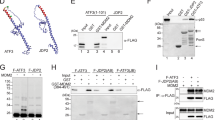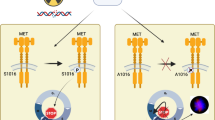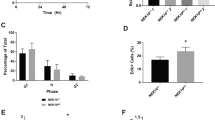Abstract
The activity of the tumor suppressor p53 is induced in response to DNA-damaging agents such as UV and γ radiation. Phosphorylation is one of the key regulatory steps for activating p53 function. Recent reports have shown that p53 is phosphorylated at both serines 15 and 392 in response to UV radiation. Phosphorylation at serine 15 prevents the binding of HDM2, a negative regulator of p53. Phosphorylation at serine 392 induces the DNA-binding function of p53. We examined the requirement for phosphorylation at both serines and show that both these modifications occur on the same molecule of p53. In vitro assays demonstrate that phosphorylation at either one of these sites is not sufficient to yield an active p53. Phosphorylation by DNA-PK, that modifies serines 15 and 37, inhibits HDM2 binding to p53 but does not induce the DNA-binding activity of p53. Phosphorylation at serine 392, on the other hand, stimulates the DNA-binding ability of p53 but does not make it immune to binding and inhibition by HDM2. Thus, our results demonstrate that multiple sites need to be modified to yield a functional p53.
This is a preview of subscription content, access via your institution
Access options
Subscribe to this journal
Receive 50 print issues and online access
$259.00 per year
only $5.18 per issue
Buy this article
- Purchase on Springer Link
- Instant access to full article PDF
Prices may be subject to local taxes which are calculated during checkout






Similar content being viewed by others
References
Agarwal ML, Taylor WR, Chernov MV, Chernova OB and Stark GR. . 1998 J. Biol. Chem. 273: 1–4.
Bannin S, Moyal L, Shieh S-Y, Taya Y, Anderson CW, Chessa L, Smorodinsky NI, Prives C, Reiss Y, Shiloh Y and Ziv Y. . 1998 Sci. 281: 1674–1677.
Baudier J, Delphin C, Grunwald D, Khochbin S and Lawrence JJ. . 1992 Proc. Natl. Acad. Sci. USA 89: 11627–11631.
Bottger A, Bottger V, Garcia-Echeverria C, Chene P, Hochkeppel H-K, Sampson W, Ang K, Howard SF, Picksley SM and Lane DP. . 1997 J. Mol. Biol. 269: 744–756.
Canman CE, Lim D-S, Cimprich KA, Taya Y, Tamai K, Sakaguchi K, Appella E, Kastan MB and Siliciano JD. . 1998 Science 281: 1677–1679.
Giaccia AJ and Kastan MB. . 1998 Genes Dev. 12: 2973–2983.
Gu W and Roeder RG. . 1997 Cell 90: 595–606.
Hermeking H, Lengauer C, Polyak K, He TC, Zhang L, Thiagalingam S, Kinzler KW and Volgelstein B. . 1997 Mol. Cell 1: 3–11.
Hupp TR, Meek DW, Midgley CA and Lane D. . 1992 Cell 71: 875–886.
Kapoor M and Lozano G. . 1998 Proc. Natl. Acad. Sci. 95: 2834–2837.
Kern SE, Kinzler KW, Bruskin A, Jarosz D, Friedman P, Prives C and Vogelstein B. . 1991 Sci. 252: 1708–1711.
Kubbatat MHG, Ludwig RL, Ashcroft M and Vousden KH. . 1998 Mol. Cell Biol. 18: 5690–5698.
Lees-Miller SP, Sakaguchi K, Ullrich SJ, Appella E and Anderson CW. . 1992 Mol. Cell Biol. 12: 5041–5049.
Levine AJ. . 1997 Cell 88: 323–331.
Lu H, Taya Y, Ikeda M and Levine AJ. . 1998 Proc. Natl. Acad. Saci. 95: 6399–6402.
Mayo LD, Turchi JJ and Berberich SJ. . 1997 Cancer Res. 57: 5013–5016.
Meek DW, Simon S, Kikkawa U and Eckhart W. . 1990 EMBO J. 9: 3253–3260.
Milne DM, Campbell DG, Caudwell FB and Meek DW. . 1994 J. Biol. Chem. 269: 9253–9260.
Okorokov AL, Ponchel F and Milner J. . 1997 EMBO J. 16: 6008–6017.
Prives C. . 1998 Cell 95: 5–8.
Reinke V and Lozano G. . 1997 Rad. Res. 148: 115–122.
Sakaguchi K, Sakamoto H, Lewis MS, Anderson CW, Erickson JW, Appella E and Dong X. . 1997 Biochem. 36: 10117–10124.
Sakaguchi K, Herrera JE, Saito S, Miki T, Bustin M, Vassilev A, Anderson CW and Appella E. . 1998 Genes Dev. 12: 2831–2841.
Shaw P, Freeman J, Bovey R and Iggo R. . 1996 Oncogene 12: 921–930.
Shieh S-Y, Ikeda M, Taya Y and Prives C. . 1997 Cell 91: 325–334.
Shieh S-Y, Taya Y and Prives C. . 1999 EMBO J. 18: 1815–1823.
Siliciano JD, Canman CE, Taya Y, Sakaguchi K, Appella E and Kastan MB. . 1997 Genes Dev. 11: 3471–3481.
Ullrich SJ, Sakaguchi K, Lees-Miller SP, Fiscella M, Mercer WE, Anderson CW and Appella E. . 1993 Proc. Natl. Acad. Sci. USA 90: 5954–5958.
Unger T, Juven-Gershon T, Moallem E, Berger M, Sionov RV, Lozano G, Oren M and Haupt Y. . 1999 EMBO J. 18: 1805–1814.
Waterman MJF, Stavridi ES, Waterman JLF and Halazonetis TD. . 1998 Nat. Genetics 19: 175–178.
Wu X, Bayle JH, Olson D and Levine AJ. . 1993 Genes Dev. 7: 1126–1132.
Wu Y, Liu Y, Lee L, Milner Z and Kulesz-Martin M. . 1994 EMBO J. 13: 4823–4830.
Zauberman A, Barak Y, Ragimov N, Levy N and Oren M. . 1993 EMBO J. 12: 2799–2808.
Acknowledgements
This study was supported by a grant from the NIH (CA47296) to G Lozano.
Author information
Authors and Affiliations
Rights and permissions
About this article
Cite this article
Kapoor, M., Hamm, R., Yan, W. et al. Cooperative phosphorylation at multiple sites is required to activate p53 in response to UV radiation. Oncogene 19, 358–364 (2000). https://doi.org/10.1038/sj.onc.1203300
Received:
Revised:
Accepted:
Published:
Issue Date:
DOI: https://doi.org/10.1038/sj.onc.1203300
Keywords
This article is cited by
-
Exogenous bacterial DnaK increases protein kinases activity in human cancer cell lines
Journal of Translational Medicine (2021)
-
Direct relationship between the level of p53 stabilization induced by rRNA synthesis-inhibiting drugs and the cell ribosome biogenesis rate
Oncogene (2016)
-
Carbon ion beam triggers both caspase-dependent and caspase-independent pathway of apoptosis in HeLa and status of PARP-1 controls intensity of apoptosis
Apoptosis (2015)
-
Prediction of functional phosphorylation sites by incorporating evolutionary information
Protein & Cell (2012)
-
Phosphorylation network rewiring by gene duplication
Molecular Systems Biology (2011)



